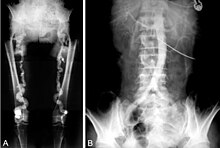Monckeberg's arteriosclerosis: Difference between revisions
m Date maintenance tags and general fixes |
Helena Stone (talk | contribs) No edit summary |
||
| Line 21: | Line 21: | ||
==Presentation== |
==Presentation== |
||
This human medial calcification, Mönckeberg’s sclerosis, is common and occurs independently of [[atherosclerosis]]. It is more frequent in people over 50 years of age and diabetics. In advanced cases of Monckeberg's medial calcific sclerosis, vessels may become rigid and lose their distensibility. |
This human medial calcification, Mönckeberg’s sclerosis, is common and occurs independently of [[atherosclerosis]]. It is more frequent in people over 50 years of age and diabetics. In advanced cases of Monckeberg's medial calcific sclerosis, vessels may become rigid and lose their distensibility. |
||
'''Monckeberg's [[arteriosclerosis]]''', also called medial calcific sclerosis, is a form of arteriosclerosis or vessel hardening, where calcium deposits form in the middle layer of the walls of medium sized vessels (the [[tunica media]]). This Human medial calcification, Mönckeberg’s sclerosis, is common and occurs independently of atherosclerosis. It is more frequent in people over 50 years of age and diabetics. In advanced cases of Monckeberg's medial calcific sclerosis, vessels may become rigid and lose their distensibility. It is associated with trophic foot ulceration and [[peripheral artery occlusive disease]]. |
|||
==Associated conditions== |
==Associated conditions== |
||
Revision as of 21:17, 17 March 2009
This article needs attention from an expert on the subject. Please add a reason or a talk parameter to this template to explain the issue with the article. (February 2009) |
| Monckeberg's arteriosclerosis | |
|---|---|
| Specialty | Cardiology |

Monckeberg's arteriosclerosis, also called medial calcific sclerosis, is a form of arteriosclerosis or vessel hardening, where calcium deposits form in the middle layer of the walls of medium sized vessels (the tunica media).[1]
It is named for Johann Georg Mönckeberg.[2][3]
Presentation
This human medial calcification, Mönckeberg’s sclerosis, is common and occurs independently of atherosclerosis. It is more frequent in people over 50 years of age and diabetics. In advanced cases of Monckeberg's medial calcific sclerosis, vessels may become rigid and lose their distensibility.
Monckeberg's arteriosclerosis, also called medial calcific sclerosis, is a form of arteriosclerosis or vessel hardening, where calcium deposits form in the middle layer of the walls of medium sized vessels (the tunica media). This Human medial calcification, Mönckeberg’s sclerosis, is common and occurs independently of atherosclerosis. It is more frequent in people over 50 years of age and diabetics. In advanced cases of Monckeberg's medial calcific sclerosis, vessels may become rigid and lose their distensibility. It is associated with trophic foot ulceration and peripheral artery occlusive disease.
Associated conditions
It is usually more benign than other forms of arteriosclerosis,[4] but can still be associated with important medical conditions.
It is associated with trophic foot ulceration and peripheral artery occlusive disease.
Its presence predicts risk of cardiovascular events and leg amputation in diabetic patients.
Mönckeberg's medial arteriosclerosis was diagnosed in 34 of 297 patients referred for pelvic radiography for a variety of reasons. It is strongly associated with metabolic bone disease, especially osteoporosis, whether induced by corticosteroids or arising spontaneously.
References
- ^ "Mönckeberg arteriosclerosis" at Dorland's Medical Dictionary
- ^ synd/4064 at Who Named It?
- ^ J. G. Mönckeberg. Über die reine Mediaverkalkung der Extremitätenarterien und ihr Verhalten zur Arteriosklerose. Virchows Archiv für pathologische Anatomie und Physiologie, und für klinische Medicin, Berlin, 1903, 171: 141-167.
- ^ "Atherosclerosis".
